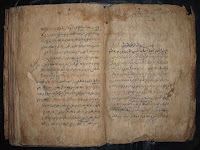This is a genuine ancient clay tablet with old Akkadian inscription from
2350-2150BC. I purchased this item from a reputed seller of an auction about 10
years ago.
Besides Egypt, Mesopotamia also adopted cuneiform writing in
their literary system.
The item is still in good condition with visible inscriptions. I have lost the document in regards to the content
of this inscription, however I still remember that it was regarding the prayer
for constructing a building or so.
Both sides are full of incused
inscription in old akkadian language.
Dimension is
50mm x 50mmx25mm
Below is an excerpt I quoted from Wikipedia in regards
to this clay tablet tradition :
"In the
Ancient Near East,
clay tablets (
Akkadian
ṭuppu(m) 𒁾[1])
were used as a writing medium, especially for writing in
cuneiform, throughout the
Bronze Age
and well into the
Iron Age.
Cuneiform
characters were imprinted on a wet clay tablet with a
stylus often made of
reed
(
reed pen).
Once written upon, many tablets were dried in the sun or air, remaining fragile.
Later, these unfired clay tablets could be soaked in water and recycled into new
clean tablets. Other tablets, once written, were grilled in a
kennal
or fired in
kilns (or inadvertently, when
buildings were burnt down by accident or during conflict) making them hard and
durable. Collections of these
clay documents made up the very
first
archives. They were at the root
of first
libraries. Tens of thousands of
written tablets, including many fragments, have been found in the Middle
East.
[2][3]
In
the
Minoan/
Mycenaean
civilizations, writing has not been observed for any use other than accounting.
Tablets serving as labels, with the impression of the side of a wicker basket on
the back, and tablets showing yearly summaries, suggest a sophisticated
accounting system. In this cultural region the tablets were never fired
deliberately, as the clay was recycled on an annual basis. However, some of the
tablets were "fired" as a result of uncontrolled fires in the buildings where
they were stored. The rest are still tablets of unfired clay, and extremely
fragile; some modern scholars are investigating the possibility of firing them
now, as an aid to preservation."


















































